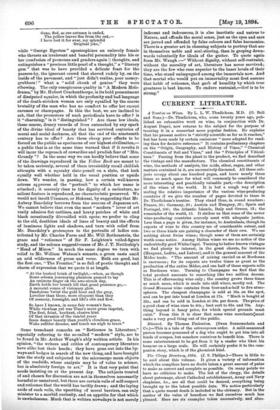CURRENT LITERATURE.
2 Treatise on Wines. By L. L. W. Thudichum, M.D. (G. Bell and Sons.)—Dr. Thudichum, who, some twenty years ago, pub- lished an exhaustive work on wine, in conjunction with Dr. August Dupre, now returns to the subject for the purpose of treating it in a somewhat more popular fashion. He explains that his present motive is "strictly scientific as far as it reaches," but has been made by certain omissions "more adapted for read- ing than for decisive reference." It contains preliminary chapters on the "Origin, Geography, and History of Vines," "Chemical Constituents of Soil and Vines," and the "Principles of Viticul- ture?' Passing from the plant to the product, we find described the vintage and the manufacture. The chemical constituents of wine, the methods of analysis, the acids, ether, sugar, and other matters contained in it, are successively discussed. All these sub- jects occupy about one hundred pages, and leave nearly three times as much space for what will commonly be considered the more interesting and practically valuable part,—the description of the wines of the world. It is but a rough way of esti- mating the relative importance of the various wine-producing countries if we give the number of pages devoted to them in Dr. Thudichum's treatise. They stand thus, in round numbers : France, 90; Germany, 20; Austria and Hungary, 20; Spain and Portugal, 100; the Atlantic Islands, Italy and Greece, 12; the remainder of the world, 15. It strikes us that some of the newer wine-producing countries scarcely meet with adequate justice. Less than a page is given, for instance, to Australasia, though its exports of wine to this country are of considerable extent, and two or three kinds are gaining a character of their own. We see nothing about Swiss wines; though some of them are certainly worth some notice. Among Italian wines we see no notice of the undoubtedly good White Capri. Turning to better-known vintages we find plenty to interest, in the great clarets, for instance (Margaux, Lafitte, and Latour), and in the general account of the Medoc trade. "The amount of mixing carried on at Bordeaux is enormous ; for its exports are twelve times as great as the production of the entire Medoc, and one half of these exports sells as Bordeaux wine. Turning to Champagne we find that the total product amounts to something like two million dozens. This is of effervescing wine only ; the country grows three times as much more, which is made into still wines, mostly red. The Grand Mousse= wine contains from four-and-a-half to five atmo- spheres. The cheapest champagne is sold at 16s. on the spot, and can be put into bond at London at 17s. "Much is bought at 22s., and can be sold in London at 28s. per dozen. The price of a good class of wine rises to 40s.; best sort to 65s. and 70s. Any- thing beyond is fancy price, for which special grounds must exist." From this it is clear that some wine merchants:must make a very good thing out of the public.






































 Previous page
Previous page